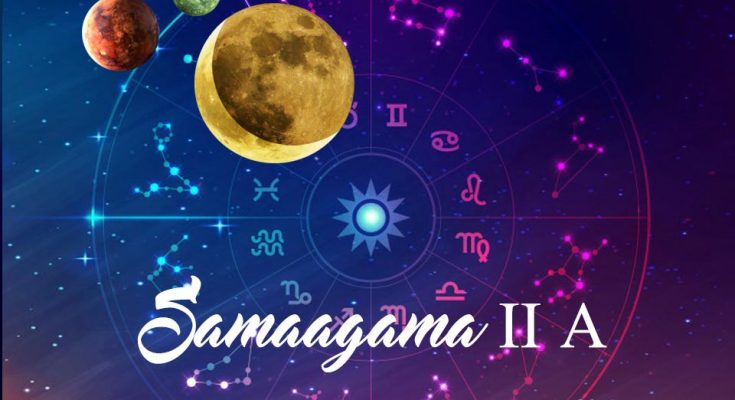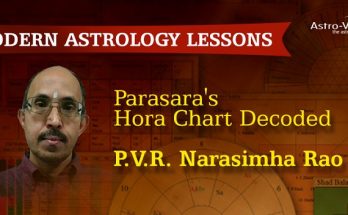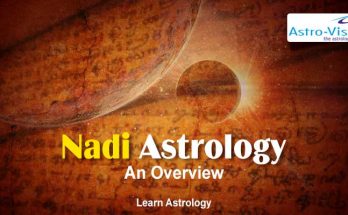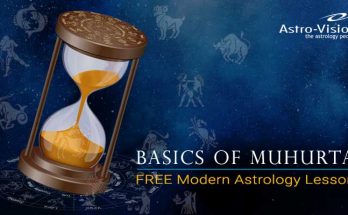Definition of Samaagama
Sloka 1, Chapter 7 of Surya Siddhanta says:
Tara grahanam anyonyam swatam yudha samagamou
samagama sasankena suryenastamayam saha
According to it, any close conjunction among the 5 planets viz., Mars, Mercury, Jupiter, Venus and Saturn (called as Tara Grahas) creates Graha Yuddha (planetary war). When they are with the Moon it is called Samaagama (conjunction) and when they are with the Sun, they become Ashangata (combust). In addition to these three, Yoga is another type of conjunction caused exclusively by the luminaries Sun and the Moon.
It may be recalled that the 27 Nitya or daily Yogas are obtained by adding the longitudes of the Sun and the Moon. Incidentally, it pertinent to note that most of the special Yogas (Raja Yogas, Nabhasa Yogas, Sankhya Yogas etc) are formed by the combination or addition of special effects of different planets as house lords in a chart and as such, the word Yoga is indicative of the effect of addition. But, when any planet is conjoined with either Rahu or Ketu, the word Grastha is used to connote the capturing of the planet by them. Out of these 5 types of conjunctions, Samaagama is a very special one because it triggers and paves the way for the occurrence of all the events in an individual’s life by causing appropriate results based on the operating Dasas and transits. Before the actual ways and means of the occurrence of such events and results are discussed, it may be necessary to re-examine and understand the full implications of this celestial event Samaagama.
Samaagama Redefined
The principle of Samaagama is mentioned in many major classical works such as Brihat Parasara Hora, Brihat Jataka, Prasna Marga, Phaladeepika, Brihat Samhita, Manasagari etc., besides texts dealing with Vedic astronomy. But, not many details are discussed in them except in Brihat Samhita and Surya Siddhanta. In most of these texts, the learned translators have preferred its meaning as a conjunction of planets with the Moon, while there are a few instances of referring to other planetary conjunctions also as Samaagama. But, after a critical study of the relevant information that could be gleaned from the sources available to me, I believe that the present connotation adopted by almost all the scholars who have translated the Sanskrit classics into English needs some revision. The following facts need to be examined in this regard.
(i)According to A Concise Sanskrit-English Dictionary by V.V.Bhide (Gian Publishing House, New Delhi, 1990 edition, page 1103), the Sanskrit word Samaagama is shown to have four meanings as follows:- (i) Union, meeting (ii) Intercourse, association, society (iii) Arrival, approach and (iv) Conjunction (in astrology) It may be noted that although there are four different meanings for the word in the dictionary, it has been hinted that the meaning conjunction is what is generally applied in astrology.
(ii)According to Astrology-Concepts Explained by G.S.Agarwal, Dr.S.K. Duggal and Chander Bhalla (Sagar Publications, New Delhi, May 2004 edition, page 310), three different meanings are given for the word Samaagama as (ii)follows:
(a)A planet in transit passing through its own radical position in the birth chart.
(b)Conjunction with the Moon — it is a kind of motion that a planet (Mars, Mercury, Jupiter, Venus, Saturn) can have.
(c)Samaagama is when a planet becomes retrograde and moves at its average speed. Such a planet gets a strength of 30 Shashtiamsas in Cheshta Bala (motional strength).
(iii)In Surya Siddhanta, Sloka 22 of Chapter 7 (Graha yuktyadikaram), Samaagama is said to be a kind of planetary fight and if (in the conjunction) both planets are very near each other and bright. This, in fact, is an elaboration of the meaning of the word Samaagama mentioned in Sloka 1.
(iv)The word Samagama appears in about 10 places in Brihat Samhita and the learned translator (M.Ramakrishna Bhat) has chosen its general meaning as “conjunction with the Moon” except in the following 2 instances.
(a) In Chapter 17 (Grahayuddha adhyaya), the learned author himself has quoted Bhattotpala’s contention as
Hasthamaatram bhaveth Yuddham Baahumaatram Samaagama
In this Sloka, the word baahumaatram has to be interpreted to mean “fighting shoulder to shoulder”. This meaning needs to be explored with much care in astrological parlance. When one talks about the ‘shoulder to shoulder bash’ of other planets with the Moon, one must remember the basic fact that the Moon is the fastest moving planet among all planets. As such, only the Moon passes over other planets. Hence, according to Bhattotpala, when the Moon actually comes in shoulder to shoulder contact with the other planets in transit Samaagama occurs.
In Chapter 18, Acharya Vishnu Chandra’s contention is quoted as
“Samaagamah Sheetha rashmi sahithaanaam”
which means that other planets enter into Samaagama with the Moon.
(b) In Sloka 5 of Chapter 20, five types of planetary combinations are listed out. While translating the Sloka, the learned translator gives the meaning of Samaagama as ‘gathering’. This meaning is very much in line with its dictionary meaning of arrival, association, union, meeting etc. It is important to note that the same meaning is also assigned by another famous scholar, the late Sri V. Subramanya Sastri who has translated more than a dozen major classics of astrology into English.
(v)In Manasagari (pages 243-299, translation by P.K.Vasudev), different words are used to mean the conjunction of planets and Samaagama is one of them, others being Samayoga, Sangama and Yoga.
(vi)In Jataka Sagaram (a Tamil work dealing with all the essential astrological calculations) by V.K.Velu Naicker (page 147 of Part 4), Samaagama is defined as
“Thingalai vandhu aduththidine Samaagamam”
This also means that Samaagama is caused when planets come and join the Moon. But, the word aduththidine in Tamil also has many meanings such as coming-up on and on, conjoining, becoming acceptable, depending upon etc.
(vii)According to Sripati Paddhati (Chapter 3, Sloka 18), the classical work dealing with the calculation of strengths of planets and houses, when there is Samaagama (conjunction of any one of the non-luminaries with the Moon) its strength is 30 Virupas. This implies that Samaagama is a source of additional strength to a planet.
Thus, it is evident that the present meaning of the word Samaagama generally adopted in astrology by the learned scholars — conjunction of planets with Moon — is only partial in nature and does not convey its full meaning. Although this meaning is not wrong, there is certainly a need to revise its meaning so as to include all that it represents. Hence, there is a need to re-examine the above facts with a view to arriving at the changes to be incorporated in the definition/meaning. The following points are note-worthy in this context:
Out of the different meanings ascribed to the word Samaagama in the dictionary, two of them — approaching, arriving at — which are presently not being used in astrology are also very relevant and the meaning of the word ‘aduththidine’ in Tamil being coming-up on and on also relates to approaching and arriving. Therefore, these connotations must be additionally adopted while interpreting the concept of Samaagama-!
to be continued…
Courtesy: Modern Astrology (Dr Revathi Vee Kumar)
Continued from: Samaagama – Part1A







